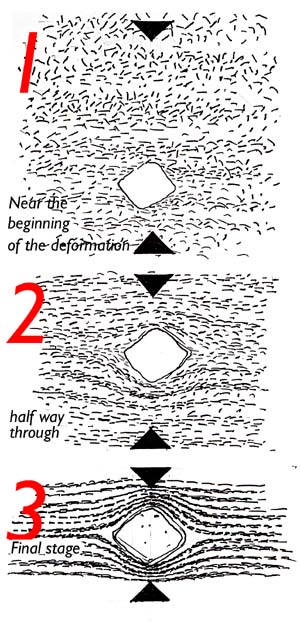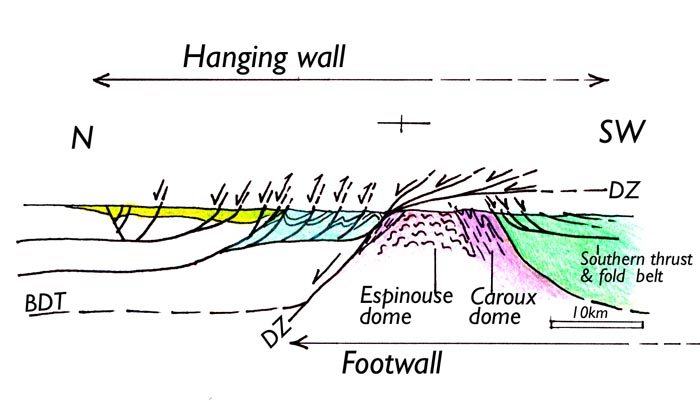|
The Gorges d'Héric form
a natural section through the Caroux Massif which offers the best
opportunity to see its spectacular "augen gneisses". The
massif is the south eastern part of a much larger gneiss (see
location 3 and 4) dome structure with an axis with a direction
of (trending) NE-SW to ENE-WSW which forms part of the Montagne
Noire. The local Caroux dome is also elongated in the ENE- WSW direction
and the bulk of the interior consists of gneiss, much of which is
"augenitic"(with yeux, or eyes). The whole is surrounded
by nappes (large overturned thrusted folds with almost parallel
sided limbs) of Palaeozoic low grade metamorphosed sedimentary rock
(metasediments) (see location 1 for
more explanation). These nappes have been associated with southwards
thrusting related to the Variscan continental collision when France
and Spain collided (Van den Driessche and Brun 1991-2).
|
|
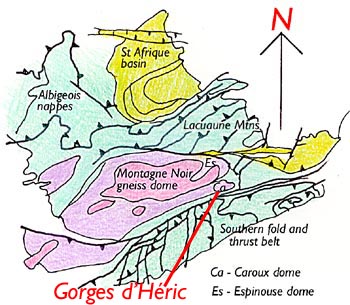 .Location and main structural
features of the surroundings.
.Location and main structural
features of the surroundings.
|
| Drawn
by Paul Proudman after Van den Driessche and Brun (1991-2) |
| |
The origin of the augen
and the rock texture
The texture of this rock is likely to have been created in conditions
of "regional metamorphism". The large ovoid to lozenge shaped
megacrysts are probably relict porphyroblasts. Quartz is easily recrystallized
and feldspar is brittle and more enduring (Spry,1969).
Quartz forms relatively fine grained, recrystallized aggregates in
the matrix where it may be accompanied by feldspar, mica and sometimes
amphiboles as foliated layers swirling around the large porphyroblasts.
The banding is compositional, i.e. due to modal variations in phases
present and created by partial melting and recrystallization, a process
called anatexis. The bands alternate between quartz rich layers which
are light in colour and thinner biotite rich layers (dark and flecked
in colour). This type of rock is associated with high grade metamorphism
of aluminous sediments. |
| |
The gneissic banding
shapes
The characteristic shape of the augen
is remarkably constant which is evidence of a process independent
of small scale compositional variations. It's likely that the relict
megacrysts of feldspar were present at the time of deformation and
metamorphism and that they resisted the deformation to a greater extent
than the other phases. The partial melting which accompanied the deformation
occurred at crystal boundaries so the large single crystals at the
centre of the eyes form a pocket of constant size and shape within
an environment of change. As the rock was squashed, the banding was
formed. As the space in the matrix diminished, the bands became more
deformed round the large crystals (Barker
1990) This all happened very slowly although some of the shapes
are reminiscent of liquid movements which seem to be swirling around
them. |
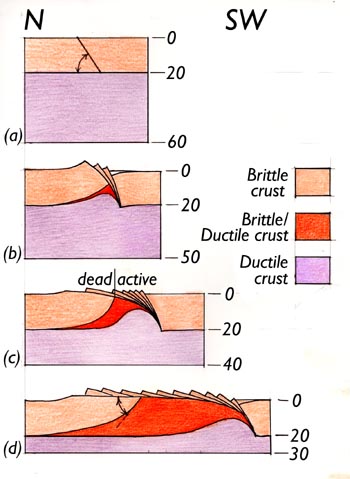
|
|
Drawn by Paul Proudman after Van
den Driessche and Brun (1991-2)
|
| |
| Four sections (above) which show
the evolution of an uplifted dome in an extensional environment. The
series shows the development of a similar fault pattern to Basin and
Range |
| |
Radiometric Dating
The climax of the Variscan shortening
and thickening event has been dated at about 320 Ma by Rb-Sr data
and by 40Ar-39Ar (Maluski et al 1991). Three
structural zones have been identified using 40Ar-39Ar |
- the migmatites and gneisses of the core
which give mica dates of 315 Ma,
- mylonites of the northern and southern
shear zones which give an age of 310 Ma,
- the nappe structures which give an age
of 279 Ma
|
| |
Evidence for late extension
On the small scale the many dykes, some up to 5m, which are seen on
the route is strong evidence for extension in some form. This extension
can occur on the outside curve of folds. If these dykes extend far
enough they can can be distinguished from fold cracks and here they
do appear to be planar on a quite large scale. On a larger scale there
are substantial coal bearing basins to both the north and the south.
The presence of basins does constitute strong evidence for extension.
The date of these basins is early enough to be contemporary with the
main dome building event at the Upper Carboniferous to the Permian. |
|
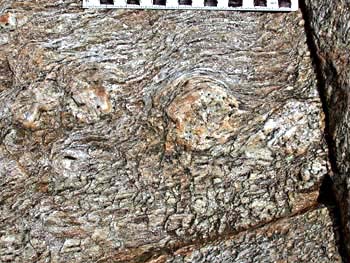 |
| A group of augen showing complex
but regular curving of the gneissic schistosity in accordance with
"orderly" deformation |
| |
The augen
The gneiss of the Montagne Noire dome
contains augen of alkali feldspar which
is a crystalline mineral composed mostly of silicon aluminium potassium
and oxygen. These large crystals (porphyroblasts) which are set in
a finer "matrix" appear to be lozenge shaped (although this
may in part be a textural artefact). They can be up to 10 cm long
but are more typically 5 or 6 cm If you get the sunlight in the
right direction it is clear that the auge is one large crystal as
the whole reflects at the same angle. Although the crystal is
of alkali feldspar there are inclusions of other minerals such as
biotite (a dark form of mica, see location
1. |
|
|
|
|
Three stages in the development
of foliation around relict feldspar porphyroblasts. Deformation is
in the direction of the arrows.
(1) Near to the beginning of the deformation there is very little
banding and very little space has been lost.
(2) The top to bottom dimension is reduced by approximately 40% and
banding is now pronounced. The curved forms around the feldspar crystal
are developing
(3) Top to bottom dimension is more than halved and banding is sharply
defined. Curved shapes around the crystal are fully formed. |
| |
Composition of the Montagne dome
As can be seen from the first large
map the Montagne Noire dome contains mostly anatectic granites (that
is, granites arising out of the partial melting of high grade metamorphic
rock), migmatites (mixtures of anatectic granite and gneiss) and high
grade metamorphic gneisses, overlain by lower grade Cambrian metamorphosed
sedimentary rock (metasedimentary) cover, which is not widely exposed.
This means that the Caroux dome of the Gorges is not made of quite
the same material as the rest of the Montagne dome. |
| |
Composition of the Caroux dome
The Caroux dome of the Gorges is of
a different composition, the anatectic granite and migmatites being
largely replaced by the augen gneiss. Although there are some pockets
of migmatites, in general the highest metamorphic grade is slightly
lower. (See the first large map).The Espinouse Dome to the north contains
mostly anatectic granites (that is, granites arising out of the partial
melting). |
| |
Geological history
All models propose a late doming in
Stephanian-Permian times. Earlier models agree with a doming event
associated with late regional compression after earlier Variscan thrusting.
For more details on these models go to: |
 |
|
These explanations
based on compressional doming are now being largely replaced by:
- a crustal thickening coinciding with
the Variscan collision and contemporary with the emplacement of
the surrounding nappe structures, followed by
- an extensional tectonic phase in Stephanian-Permian
times which caused the doming to develop as a response to gravity
collapse due to crustal thickening.
The extensional phase includes strongly
asymmetrical strain and metamorphic patterns. The extension is caused
by gravity spreading of the thickened crust, with accompanying basin
and range formation. Ductile fabrics acquired in the Variscan compressive
phase are retained. The Montagne Noire is now considered to be an
important example of the spreading of a thickened crust and the
strain and metamorphic patterns which can go with this process.
|
|

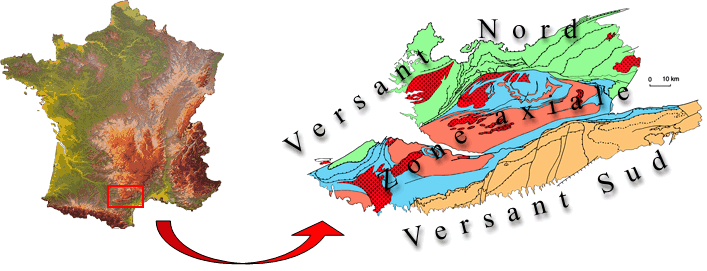
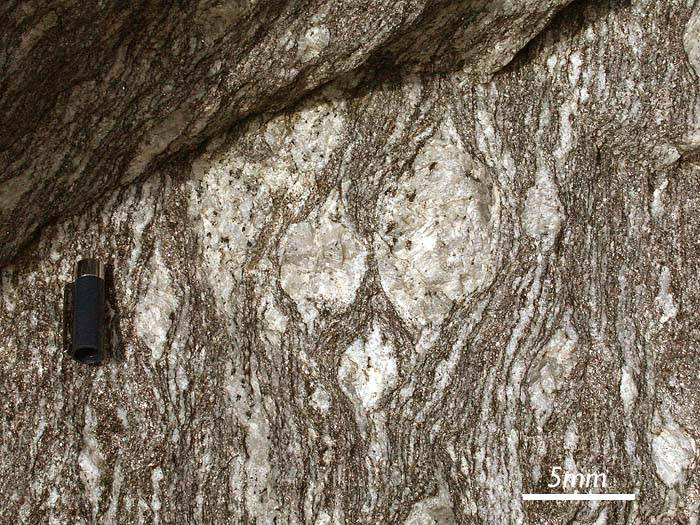
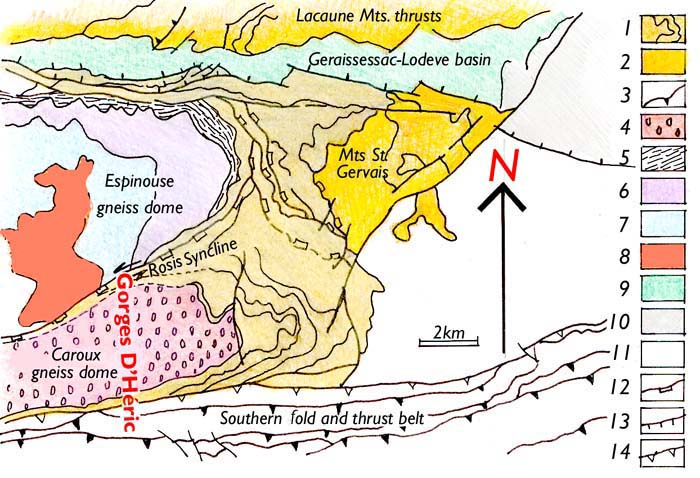 Structural sketch map of the eastern
part of the Montagne Noire (Drawn by
Paul Proudman after Van den Driessche and Brun (1991-2))
Structural sketch map of the eastern
part of the Montagne Noire (Drawn by
Paul Proudman after Van den Driessche and Brun (1991-2)) .Location and main structural
features of the surroundings.
.Location and main structural
features of the surroundings.

